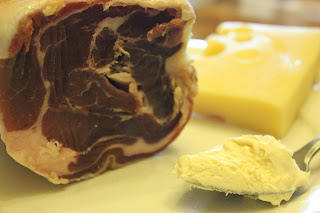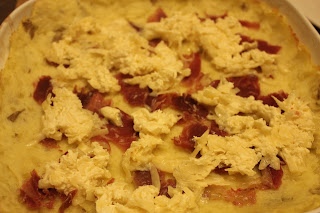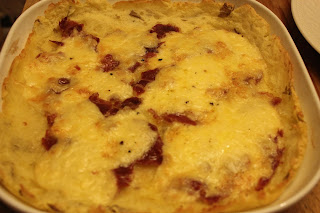With its exact origins lost in the mist of time, Trifle like its close cousin syllabub, seems to have evolved from a drink, which was often used to treat ailments such as colds and chills and was known under the collective title of posset. Variations of this beverage, made of milk, flavoured with wine and spices, had been popular since Elizabethan times, when they were also made in richer versions and used to celebrate weddings and feast days. The most famous perhaps, is 'lambs-wool', which also like trifle contained fruit, in this case roasted apple and was the traditional wassail or toast given in apple orchards at the beginning of the year to ensure a good crop. The wassail bowl was associated with an English version of first footing wherein the steaming drink was carried from neighbour to neighbour, to spread the good luck around.
The Victorians took this simple drink and turned it into something more substantial, an 'eating-posset', with the addition of cakes or sponge biscuits, rich egg custard and a decorative, sliced blanched almond topping. In fact true traditional English trifle was always decorated in the same way.
Even so, in Mrs Beeton's book of Household Management 1920s edition, milk posset still figured on the menu and interestingly in the Invalid Cookery section. There were also earlier versions of trifles which used syllabub as the top layer and which included bread or ratafias as the base. There was also 'sack posset' made from a fortified wine, the exact origin of which is unknown but which is now associated with sherry. Sherry Trifle was always something we had/have as a celebration dish on birthdays and at Christmas, usually on Boxing Day and I always love the way in which these dishes and recipes have been handed down for centuries and used on similar occasions. So this is not just a recipe but a celebration of good food, good health and good companionship for the beginning of a new year, a Happy Birthday or any great occasion, although personally I could eat trifle any time!
Queen of Cakes
The basis of this trifle recipe is a Victoria sandwich, which in itself is an interesting and historical item, as it marked the birth of that great institution known as afternoon tea, as 'invented' by one of Queen Victoria's Ladies in Waiting. Legend has it, that the latter had noticed what she referred to as 'a sinking feeling' due to the long wait between the relatively new institution of 'lunch' and the subsequently much later evening meal. Afternoon tea gave life to further innovations, such as tea rooms and tea parties, new forms of china and table linen, special furniture and of course, the tea gown (here left by Worth), which the next generation of Edwardians went on to make their own. All due to one woman's understanding of her blood sugar levels.
In The Private life of the Queen by a member of the Royal Household published in 1897, the anonymous author wrote:
'There is no doubt that Her Majesty has a strong weakness for afternoon tea...It is principally to supply the Queen's tea table that the confectionery cooks are kept busy all year round at Windsor. Among the favourites of the Queen are chocolate sponges, plain sponges, wafers of two or three different shapes, langues de chat, biscuits and drop cakes of all kinds, tablets, petits fours, princess and rice cakes, pralines and almond sweets and a large quantity of mixed sweets.'
The Queen as an avid devotee of this new fashion was to have one of her favourite cakes named after her. Over the years the recipe has not changed much and it is interesting that Mrs Beeton places it outside her section on Bread, Biscuits and Cakes and puts it in merely as an adjunct to Trifle, which indeed as it is a very plain and rather basic cake, might be a good place for it.
MATERIALS
If you are really lucky and I envy you, you will have a proper good old-fashioned pair of sandwich tins in which to to bake a Victoria sponge. If you haven't then good luck finding them because everything here and in the UK is non-stick, which I don't use. For the above trifle, which I made in Scotland this Christmas, I borrowed one of my Mother's tins but for the one I made this weekend I had to use a 1 litre/2 pint glass Pyrex bowl, which really altered the cooking times. Somewhere in an unopened tea chest, I know there is a pair of these tins beckoning, otherwise a trip to a city with a professional catering shop is called for.
For the trifle dish itself you can really go to town and do it justice with the many examples of cut glass you can either cadge from a relative, they've all got them at the back of a kitchen cupboard or pick up relatively cheaply at a bric-à-brac shop or flea market. Mine shown here, was my grandmother's.
INGREDIENTS Foreword - The Great Jelly (Jello) Heresy
The first problem with looking at jelly as not just an ingredient but in fact part of the base layer for trifle, is a linguistic one. As you will see from my title the word 'jelly' in English English becomes 'jello' in American English. People quote Hannah Glasse's recipe as being proof positive that jelly is not just a modern 1950's/60's addition. Here is the actual line from the 1751 edition The Art of Cookery Made Plain and Simple, wherein this dish was first introduced on page 285, under the title 'To make a Trifle':'...You may garnifh it with Ratafia Cakes, Current Jelly and Flowers.'
Allowing for the old English long s, this is a description not only of the topping of the trifle but 'jelly' in English English is also used to denote, as here, seedless jam. In fact many of my great Aunts, when on an economy drive or just short of ingredients, in lieu of fresh or candied fruit (or flowers) would dot the top of custard puddings of all types with little mounds of jam. To my mind the inclusion of jelly aka jello is a hideous modern contrivance, due to the fact that the glorious trifle, with its roots deep into the Elizabethan kitchen and apothecary had transmogrified by the mid 20th century into a packet dessert.
But enough of this, on with the recipe.
INGREDIENTS Proper
For the Victoria Sandwich100g (4oz) butter,
100g (4oz) raw cane sugar
100g (4oz) self-raising flour (this does not exist in France but unusually for me I had this to hand as I brought it back from Scotland)
2 ordinary or 3 bantam eggs
For the custard
500ml (half a pint) of raw milk
100g (4oz) raw cane sugar (my cooking sugar has vanilla pods embedded)
3 ordinary or 4 bantam eggs
To complete the Trifle
Sherry or Brandy (optional)
Raspberry jam (jelly)
Raspberries in this case home-grown - a couple of handfuls from our freezer
at least 250ml (half a pint) of raw thick cream
Flaked almonds (if you have them to hand)
METHOD
Pre heat the oven to 190°C (375°)
This by the way is half the usual ingredients for a Victoria Sandwich, as we are only using it for the base of a trifle.
Cream together the butter and sugar with a fork.
Add the eggs and whisk or mix to a smoothish batter if the batter seems slightly curdled in appearance you can add a dessert spoon of flour but it doesn't really matter.
Gently fold in the flour so as not to lose the air beaten into the batter and then put the mixture into a greased, 20cm (8") sponge cake tin. Smooth it down carefully with the back of a spoon to achieve an even thickness.
Place in oven, in the middle shelf for around 15 to 20 minutes. If all you have is a pint pyrex dish as I did then it will take almost twice as long but you will need to check it at the 20 minute stage.
When your cake has risen and has gone golden brown on top, remove it from the oven and test it by gently laying your hand on the top, it should feel firm but springy to the touch. If you are worried at all that it may not be cooked you can stick a wooden cocktail stick into the centre and press it down, if the stick comes out clean the cake is cooked. Otherwise put it back in the over for another five minutes and then repeat the process. When it is cooked leave it to cool for a few minutes until it shrinks away from the sides of the tin, then you should easily be able to extract the cake and put it on a cooling rack.
To make the custard
Heat the milk in a saucepan until it is warm but not boiling, if you do not have vanilla sugar, then when you are heating the milk, add half a vanilla pod, I usually split the pod down the middle which allows for a richer vanilla taste.
Add the warm milk and then pour all the ingredients into the pan and place on a low heat, I use a wood stove so I just have to judge this. If you are making custard for the first time then you might want to use a bain marie but if you are careful you should be fine. You must start stirring and keep stirring, right from the moment you place the pan on the heat. Keep an eye out for when the mixture starts to coat the back of the spoon, this means it is beginning to thicken. Sometimes I continue for just a little while longer to make sure I have the right consistency, I make a lot of ice-cream so I am very used to knowing when the custard is forming to my liking. It is quite a lengthy exercise and can take 15 to 20 minutes. Once you get used to it though, I assure you, you will never use custard powder again, there is absolutely no comparison between a home made egg custard and one thickened with flour.
Jam Sandwiches
I use a heaped dessert spoon of fruit and a sprinkle of sugar to make a little jam. Obviously if you have this you can just use it straight from the jar.
Split the cake into two. Then divide the 'sandwich' into quarters. Spread the bottom half of each individual sandwich with jam and place them in the glass dish. Now put the tops on your sandwiches.
Sprinkle with sherry or brandy or just the juice from the fruit. Spoon on the fruit. In my Christmas trifle I also added a layer of preserved peaches under the cake. Allow to stand for a few minutes to allow it to soak into the sponge.

Add the custard and finally whip up the cream if necessary, decorate with the same fruits as used in the trifle or candied fruit and/or flaked almonds, which can first be toasted.
A traditional trifle should be seen through the glass in all its separate layers.
If you've enjoyed this post then please feel free to share it, ask questions, comment and/or join this blog.
Hope to see you here again for another recipe from an old farmhouse in Normandie,
Sue
Return to 'WHAT'S ON THE MENU' for more Simply Organic Recipes
© 2015 Sue Cross
Image of Lily Langtry in a Worth Teagown c1890 thanks to flickr Sacheverelle
Live Links:
Mrs Beeton's Book of Household Management 1861 is available as a pdf from the Internet Archive, including free downloading in various forms
as is Hannah Glasse's The Art of Cookery Made Plain and Simple - they have various versions including this from 1784, which has the trifle recipe on page 294 (the 1751 edition is here at the Florida State University Digital Library)
and also at the Internet Archive you can find:
The Private life of the Queen by a member of the Royal Household published in 1897

























